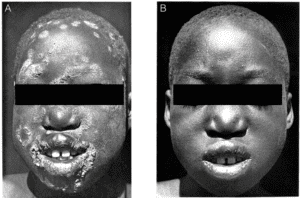Howard Fischer
Uppsala, Sweden
“Our Doc who is in the National Palace for life, hallowed be Your name by present and future generations. Your Will be done in Port-au-Prince and in the countryside…”
— Translation of part of the “Catechism of the Revolution” that was recited daily by Haitian schoolchildren

François Duvalier, M.D. (1907–1971) was the corrupt, dictatorial, murderous president of Haiti from 1956–1971. His ubiquitous secret police, the Tontons macoute, or Tontons makout in Haitian Creole, carried out his orders and killed more than 30,000 political opponents and their families.1 Duvalier received the name “Papa Doc” as a sign of affection and respect for his work as a doctor caring for Haiti’s poor villagers before he turned to politics.
Duvalier had always wanted to become a physician.2 Graduating from the Haitian National University School of Medicine in 1934, he practiced as a rural physician until 1943. He then became part of a US Army-sponsored program to prevent yaws and malaria in Haiti and was sent to the University of Michigan Graduate School of Public Health from 1944–1945 for further study.3 On his return to Haiti, he continued to treat patients with yaws.
The prevalence of yaws in Haiti in 1949 was between 40–60%.4 Yaws is an infectious disease found in warm, humid, tropical forest areas. It is seen mostly among poor populations in Africa, Asia, and Latin America. At least three-fourths of those affected are children younger than fifteen years old, mostly between six and ten years old. It is currently endemic in thirteen countries,5 and 85% of cases come from Papua New Guinea, Ghana, and the Solomon Islands.6
Yaws can involve skin, cartilage, and bone. The causative organism is a spirochete, Treponema pallidum subspecies pertenue, a close cousin of the cause of syphilis, Treponema pallidum. After a person has direct contact with an infected lesion, the organism enters through a small scratch in the skin. There is no sexual transmission of this treponema, nor does it infect the fetus of an infected woman. About three weeks after infection, a hard, round swelling of the skin appears at the site of infection. This 2–5 cm lesion is known as the “mother yaw.” It ulcerates and heals over in a few weeks. The second stage of yaws occurs a few weeks to two months later, with joint and bone pain, fatigue, fever, and new skin lesions. The pain is caused by periostitis and sometimes osteomyelitis.
Tertiary-stage yaws occurs in fewer than 10% of patients about five years after the second stage. Destructive gummas, identical to that of syphilis, appear in skin, bone, and cartilage.7-9 “There are not, in the whole of medicine, two diseases as similar as syphilis and yaws – so similar in their clinical manifestations…clinical course…causative organisms…in their serological reaction…in their response to treatment.”10 Syphilis and yaws can now be diagnosed specifically and separately by PCR genetic testing of the organism recovered from a lesion.11
Duvalier became the director of Haiti’s public health service in 1946 and Minister of Health and Labor in 1949. In 1950, a joint effort to eradicate yaws was started by the Haitian government, the Pan-American Sanitation Bureau, the World Health Organization, and UNICEF. Two-and-one-half million people were treated, out of a population estimated to be three million. One dose of intramuscular penicillin was given, at a cost of about $0.30 per person. By 1955, fewer than 1% of the population of Haiti was infected.12 Desowitz has written,”…if anything can be called a miracle cure, it is penicillin’s action on T. pertenue. Within days of a single injection…the yaws lesions began to resolve.”13
This effort was then introduced in forty-six countries and 300 million people were treated. The success rate of treatment was 95%. The eradication program, however, became a victim of its own success. Surveillance slackened and the disease re-emerged in the 1970s.14 A lesson had been forgotten: “In eradication work there are no half-way accomplishments: The campaign is either a 100% success or a failure.”15
By 1995, there were 460,000 cases of infectious yaws worldwide. The infection responds well to one oral dose of the antibiotic azithromycin, at a cost of 0.5 euro/dose.16
Duvalier left government in 1950 because of political conflicts and resumed the practice of medicine. In 1956 he ran for president and won. Haiti became an island of one-man rule, with no toleration of dissent. Duvalier had a myocardial infarction in 1959 and spent nine hours in a coma. He probably suffered neurological damage during the coma and emerged with even more bizarre beliefs about himself, his powers, and the nation.17 He died in 1971 of heart disease.
References
- François Duvalier. Wikipedia.
- François Duvalier. Biography-IMDb -imdb.com.
- François Devalier. Wikipedia.
- GE Samane. “Treponematosis eradication, with special reference to yaws eradication in Haiti,” Bull World Health Organ, 15(6), 1956.
- Yaws. WHO.int.
- Oriol Mitjá, Michael Marks, Diby Konan, et al. “Global epidemiology of yaws: A systematic review,” Lancet, 3(6), 2015.
- Yaws. Wikipedia.
- Parvin Azimi. “Nonvenereal treponema infections,” In Kliegman, Behrman, et al, eds. Nelson Textbook of Pediatrics, 18th ed, Philadelphia: Saunders, 2007.
- Mike Seear. Manual of Tropical Pediatrics, Cambridge: Cambridge University Press, 2000.
- Bruce Barrack. “Syphilis and yaws,” AMA Arch Derm, 73(5), 1956.
- Yaws. Wikipedia.
- NA. “A miraculous healing of yaws,” Am J Pub Health, Feb 1955. ajph.aphapublications.org.
- Robert Desowitz. Tropical Diseases: From 50,000 BC to 2500 AD, London: Flamingo, 1997.
- NA. “Yaws,” 2021. emedicine.medscape.com.
- Samame. “Treponematosis.”
- emedicine. “Yaws.”
HOWARD FISCHER, M.D., was a professor of pediatrics at Wayne State University School of Medicine, Detroit, Michigan.

Leave a Reply